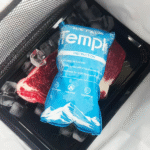Pembuangan yang tepat dari paket es kering sangat penting untuk keselamatan dan tanggung jawab lingkungan. Di dalam 2025, Ada peraturan yang lebih ketat dan alternatif yang lebih baik untuk metode pembuangan tradisional. Artikel ini akan memandu Anda melalui praktik pembuangan teraman, tindakan pencegahan keselamatan, Pertimbangan Lingkungan, dan kepatuhan hukum yang diperlukan untuk menangani es kering secara bertanggung jawab.
-
Metode teraman untuk membuang paket es kering
-
Bagaimana menghindari kerusakan lingkungan dari pembuangan yang tidak tepat
-
Pedoman hukum yang harus diikuti saat membuang es kering
-
Risiko salah menangani es kering selama pembuangan
-
Alternatif ramah lingkungan untuk es kering
Apa itu es kering dan mengapa membutuhkan pembuangan khusus?
Es kering adalah karbon dioksida padat (Co₂) digunakan terutama sebagai refrigeran di industri seperti pengiriman makanan dan transportasi medis. Karena menyublimkan langsung ke dalam gas, es kering tidak meninggalkan residu cairan, Tetapi proses ini membutuhkan penanganan khusus untuk menghindari risiko kesehatan dan lingkungan.
Bahaya kunci pembuangan yang tidak tepat
Pembuangan yang tidak tepat dapat menyebabkan radang dingin, asfikasi Karena oksigen yang dipindahkan, dan bahkan ledakan dari penumpukan tekanan dalam wadah tertutup.
Cara membuang paket es kering dengan aman
1. Biarkan es kering sublimlim di daerah yang berventilasi baik
Cara teraman untuk membuang es kering adalah dengan membiarkannya sublimlim di tempat terbuka, Ruang berventilasi dengan baik. Jangan mencoba membuangnya dalam wadah yang disegel, tempat sampah, atau air, karena ini dapat mengakibatkan reaksi berbahaya.
-
Lokasi: Pilih area luar yang berventilasi baik.
-
Jangka waktu: Potongan kecil sublimlim dalam jam; Blok yang lebih besar mungkin terjadi 24 jam.
-
Tip pengaman: Selalu pakai sarung tangan terisolasi untuk melindungi kulit Anda dari radang dingin.
2. Jangan menyegel es kering dalam wadah
Menempatkan es kering dalam wadah yang disegel dapat menyebabkan a penumpukan tekanan, mengarah ke ledakan potensial. Selalu pastikan bahwa wadah terbuka atau terbuat dari bahan yang dapat menahan tekanan penumpukan gas.
3. Hindari membuang es kering ke dalam air
Jangan pernah menempatkan es kering di dalam air. Saat terendam, Ice kering dengan cepat, menghasilkan gas dalam jumlah besar yang dapat menyebabkan penumpukan tekanan, berpotensi menghasilkan ledakan.
Apa risiko pembuangan paket es kering yang tidak tepat?
Pembuangan es kering yang tidak tepat menghadirkan beberapa bahaya:
-
Asfikasi: CO₂ menggusur oksigen dalam ruang terbatas, menyebabkan mati lemas.
-
Radang dingin: Kontak kulit langsung dapat menyebabkan kerusakan jaringan yang parah.
-
Ledakan: Menyegel es kering dalam wadah menyebabkan penumpukan tekanan.
Dampak lingkungan dari pembuangan es kering
Sedangkan CO₂ adalah zat yang terjadi secara alami, Pembuangan yang tidak tepat - seperti di tempat pembuangan sampah atau ruang terbatas - dapat meningkatkan konsentrasi co₂ secara lokal. Dampaknya minimal saat es kering disublimasikan di area terbuka, Tetapi jumlah besar atau ditangani dengan tidak benar Es kering dapat berkontribusi pada kerusakan lingkungan.
Praktik pembuangan ramah lingkungan
-
Praktik terbaik: Biarkan es kering menjadi sublimat di luar ruangan.
-
Alternatif: Mempertimbangkan Gel Ice Packs atau Bahan perubahan fase (PCMS) untuk alternatif pendinginan ramah lingkungan.
Pedoman hukum dan peraturan untuk membuang es kering
Es kering sering diklasifikasikan sebagai bahan berbahaya, membutuhkan metode pembuangan khusus sebagaimana diuraikan oleh peraturan lokal. Sangat penting untuk mengikuti undang -undang federal dan negara bagian untuk memastikan keselamatan dan tanggung jawab lingkungan.
Untuk tipnya: Selalu berkonsultasi dengan otoritas pembuangan limbah berbahaya lokal untuk memastikan kepatuhan dengan peraturan terbaru.
Apakah ada alternatif yang lebih aman untuk dikeringkan?
Ya, Beberapa alternatif lebih aman dan lebih ramah lingkungan:
-
Gel Ice Packs: Dapat digunakan kembali dan tidak beracun, Mereka adalah pilihan yang berkelanjutan untuk pengiriman yang peka terhadap suhu.
-
Bahan perubahan fase (PCMS): Ideal untuk penggunaan medis atau farmasi, Bahan-bahan ini menawarkan kontrol suhu yang tahan lama dengan dampak lingkungan minimal.
-
Kemasan ramah lingkungan: Paket es biodegradable yang muncul dirancang untuk keberlanjutan, Menawarkan metode pembuangan yang lebih aman daripada es kering.
2025 Tren pembuangan es kering
Dengan peraturan lingkungan yang lebih ketat dan teknologi baru, Pembuangan es kering menjadi lebih aman dan lebih berkelanjutan. Di dalam 2025, berharap untuk melihat:
-
Peningkatan regulasi: Pemerintah di seluruh dunia sedang memperketat undang -undang untuk mengekang kerusakan lingkungan.
-
Inovasi Teknologi: Sistem yang lebih efisien untuk menangkap emisi CO₂ muncul.
-
Alternatif berkelanjutan: Lebih banyak industri mengadopsi Biodegradable atau alternatif yang dapat digunakan kembali.
Perkembangan terbaru
-
Solusi Pengemasan Berkelanjutan: Penelitian berfokus pada metode pendinginan yang tidak beracun.
-
Sistem Pembuangan Otomatis: Merampingkan proses pembuangan industri.
-
Penegakan Peraturan: Negara -negara mengintensifkan peraturan untuk membatasi emisi CO₂.
FAQ
Q1: Dapatkah es kering dilemparkan ke tempat sampah?
TIDAK, Es kering tidak boleh dilemparkan ke tempat sampah karena potensi bahaya seperti penumpukan gas. Selalu biarkan itu sublimlim di daerah yang berventilasi baik.
Q2: Apa yang terjadi jika es kering dibuang dengan tidak benar?
Pembuangan yang tidak tepat dapat menyebabkan sesak napas, radang dingin, dan ledakan. Selalu ikuti protokol keselamatan untuk menghindari risiko ini.
Kesimpulan
Membuang es kering dengan benar sangat penting untuk mencegah bahaya keselamatan dan bahaya lingkungan. Dengan mengikuti pedoman yang diuraikan dalam panduan ini, Anda dapat memastikan bahwa Anda menangani es kering secara bertanggung jawab. Selalu pilih sublimasi terbuka atau berkonsultasi dengan otoritas lokal untuk jumlah besar.
Langkah selanjutnya:
-
Buang es kering di ruang luar yang berventilasi baik.
-
Jelajahi alternatif ramah lingkungan seperti paket gel dan PCM.
-
Tetap diperbarui dengan undang -undang setempat untuk memastikan kepatuhan dengan standar keselamatan.
Tentang tempk
Tempk mengkhususkan diri dalam logistik rantai dingin, menawarkan aman, solusi berkelanjutan untuk menangani es kering dan barang yang sensitif terhadap suhu. Produk inovatif kami, termasuk Paket es yang dapat terurai secara hayati Dan bahan perubahan fase, Pastikan tanggung jawab lingkungan tanpa mengorbankan kinerja.
[Hubungi Tempk hari ini untuk mempelajari lebih lanjut tentang solusi rantai dingin kami.]
























